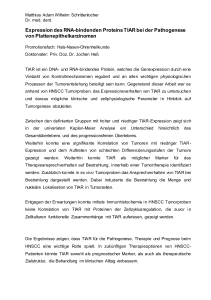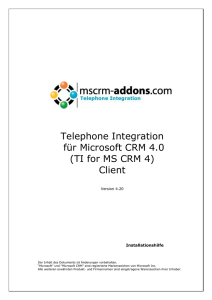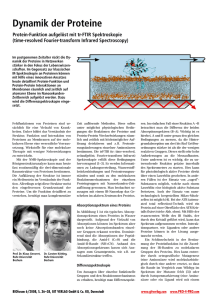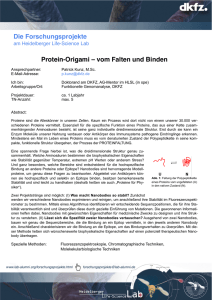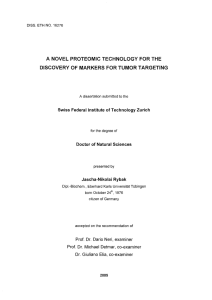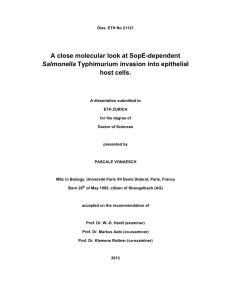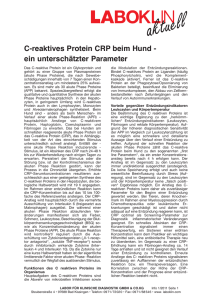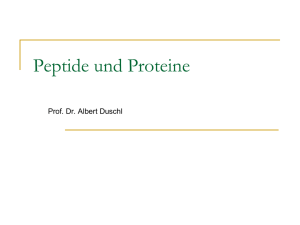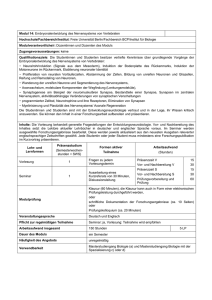Diss. ETH - ETH E
Werbung
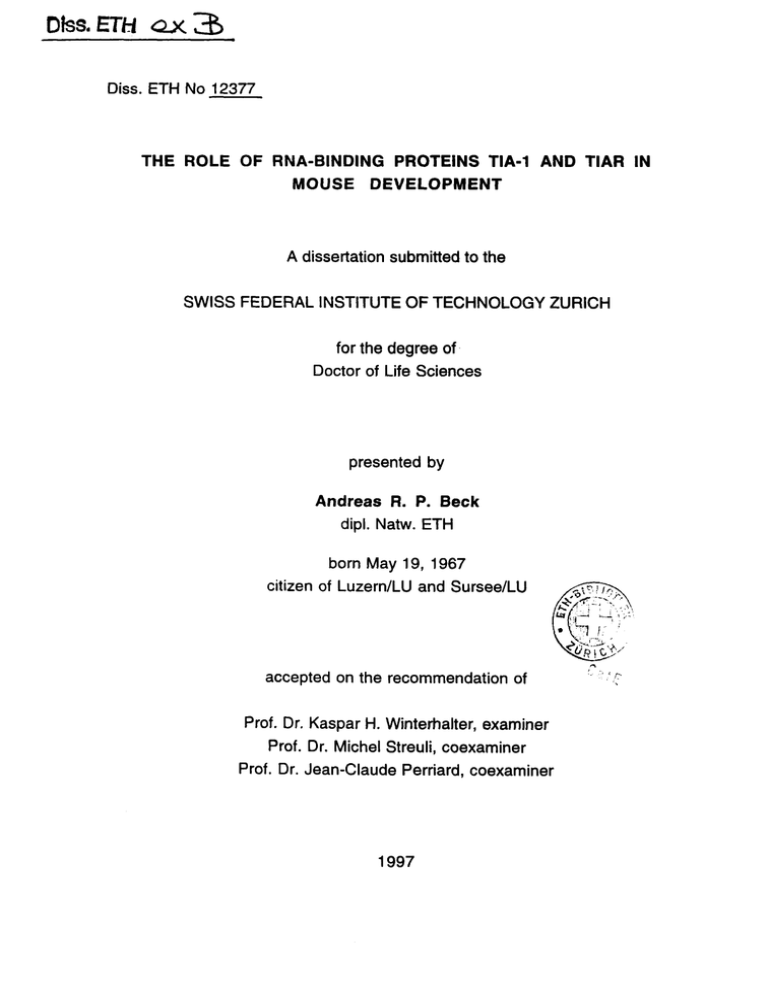
Diss. ETH <2x3> Diss. ETH No 12377 THE ROLE OF RNA-BINDING MOUSE PROTEINS TIA-1 AND TIAR IN DEVELOPMENT A dissertation submitted to the SWISS FEDERAL INSTITUTE OF TECHNOLOGY ZURICH for the degree of Doctor of Life Sciences presented by Andreas R. P. Beck dipl. born Natw. ETH May 19, 1967 citizen of Luzern/LU and Sursee/LU accepted Prof. Dr. on the recommendation of Kaspar H. Winterhalter, examiner Prof. Dr. Michel Streuli, coexaminer Prof. Dr. Jean-Claude Perriard, coexaminer 1997 I SUMMARY SUMMARY usually associated RNA is RNA-binding proteins with ribonucleoprotein (RNP) particles revealed of different variety a RNA-binding proteins. The RNA molecules are the role for many of these examples with specific RNA-binding These include functions. transcription, splicing, nucleocytoplasmic transport, translational activation, RNA stability, and RNA degradation. proteins play a key role mental retardation Drosophila, RNA-binding In vertebrates, little is known during development. is caused syndrome and is characterized proteins In RNA-binding proteins during development. The fragile about the function of elav-like led to the identification conferring RNA binding. Although is unknown, there control of protein particles RNP regulatory sequences that represent specific binding sites themselves contain proteins Systematic analysis of . RNA-binding proteins and of families of structural motifs for to form structures called by by lack of expression of RNA-binding an neural defects and macroorchidism. is present in mammalian neuronal X cells, although A family of not much is known about their function. Analysis of TIA RNA-bindina proteins. TIAR (TIA-1 related) RRM/RNP motif regulation closely two are family originally of cell survival and TIA-1 (T-cell related antigen-1) intracellular apoptosis. The aim of implicated this thesis was to function of TIA-1 and TIAR during 1 and TIAR in the revealed that the murine TIA-1 and TIAR mouse mouse similar to their human counterparts. the amounts of TIAR also mouse Analysis of TIA-1 and TIAR Knowledge into thirteen of the gene structure revealed development, viability. split are through homologous mice being present spleen recombination. that as was both Whereas the both TIA-1 tia-1-1' and exons are highly expression and testis, with distributed are over structurally about 25 kb. used to inactivate the tia-1 and tiar genes Analysis and TIAR tiaH- surviving tia-H' smaller than their littermates study the in the liver. Characterization of tia-1 and tiar genes demonstrated that these genes similar and both in the development. Characterization of TIA- revealed abundant expression of both proteins in brain, significant of the RNA-binding proteins identified in humans and and of the TIA-1 and TIAR knockout play important mice have mice roles significantly appear normal, the tiaH' throughout development, during reduced a mice but attain similar are weights 8. SUMMARY after reaching analysis adulthood. reveals the stromal a The adult complete lack of tiaH' mice sterile, and histological are oogonia and spermatogonia, components of the male and female gonads gross structures of the sexual organs appears normal. cells in normal day 7.5 in the the hindgut embryos, the primordial germ cells, extraembryonic mesoderm and after genital ridges, to the where they development of primordial germ The are present and the progenitors of germ first found at arrive around cells though embryonic gastrulation migrate through and establish themselves to later differentiate into The are even embryonic day 11.5 oocytes and spermatozoa. during the migratory phase is tiaH' embryos. Only a few primordial germ cells are present at the genital ridge of tiaH' embryos at embryonic day 11.5, and none can be found at impaired in embryonic day populate the 13.5. In normal wildtype genital ridge impair primordial germ cell mice about 25'000 at embryonic day development during found in the genes for the c-kit/steel the primordial 13.5. Mutations known to migratory phase are also receptor/ligand pair, suggesting involvement of TIAR in the control of the cellular response to signaling. germ cells an growth factor Furthermore, the structural similarity between Drosophila elav and TIAR suggests that TIAR could have development as elav has in neuronal a similar function in development. primordial germ cell 1 ZUSAMMENFASSUNG ZUSAMMENFASSUNG RNS ist komplexiert normalerweise ribonukleoprotein (RNP) -Strukturen. systematische Analyse Die Kontrollsequenzen, die verschiedenen die Bindungstellen fur Proteine darstellen und ihres Metabolismus Aspekte Beispiele Funktionen. Diese Spleissens, reguliert beinhalten Stabilitat und des Abbaus RNS-bindende wichtige Funktion von "fragile von Proteine Funktionen Das RNS-bindenden von die Regulation in der es einige gut mit wohldefinierten Transkription, des der Translation, der der Drosophila Embryonalentwicklung In Vertebraten ist nur X mental retardation syndrome" Proteinen kommt in Nervenzellen von Embryonalentwicklung. ist verursacht durch fehlende Eine Familie Saugern bekannt iiber die wenig RNA-bindenden Proteinen wahrend der eines RNS-bindenden Proteins. Expression gibt Obwohl die RNS. uben aus. uber welche werden. Proteinen nukleocytoplasmatischen Transports, des der RNP- Die RNS Molekule ihrerseits enthalten in Familien. zellulare Funktion vieler dieser Proteine unbekannt ist, untersuchte so Strukturmotiven Domanen und Identifizierung RNS-bindender Einteilung sowie deren bildet und Menge verschiedener RNS-bindender Proteine zutage Strukturen brachte eine und erlaubte die Proteinen mit vor, aber von Elav-ahnlichen wenig ist uber deren Funktion bekannt. Analvse der TIA RNS-bindenden antigen") und TIAR (fur proteine und Menschen gehoren zur der Embryonalentwicklung Die ergab, Analyse (fur "T-cell intracellular related") sind zwei eng verwandte RNS-bindende und in Sie wurden Zusammenhang mit der urspriinglich Regulation Funktion der Maus. Die von TIA-1 Charakterisierung und von TIAR in im von Apoptose der Zelle gebracht. Das Ziel dieser Dissertation Untersuchung der Maus TIA-1 RRM/RNP-motiv Familie. nachgewiesen Uberleben und die "TIA-1 Proteine. war der TIA-1 und TIAR in dass sich die Maus- und die Menschformen sehr ahnlich sind. der TIA-1 und TIAR Expression zeigte dass beide im Gehim, der Milz, und den Hoden stark exprimiert werden, und TIAR wird zusatzlich in der Leber vorgefunden. Die Charakterisierung der tia-1 und tiar Gene ergab, dass sich die beiden Gene strukturell ahnlich sind und beide 13 Exonen verteilt uber 1Q ZUSAMMENFASSUNG etwa 25 kb enthalten Beide Gene wurden in der Maus durch . tia-H' Rekombination inaktivert. tia-H' Mause sind steril Die Mause normal aufgrund grobe Struktur des Fehlens primordialen Keimzellen sind Tag 7.5 der Embryos zu Embryonalentwicklung Spermatozoa differenzieren. Die Wanderphase ist in wahrend der primordiale Keimzellen Embryonal-entwicklung finden sich dann Rezeptor legt die Signal ca. und seinem Entwicklung von im sind an den und konnen zum ersten Mai am Mesoderm etablieren Genitalanlagen den in den Liganden, einer Funktion spater sie sich Keimzellen wie Funktion von von Elav in der am Oozyten zu Tag und Entwicklung der primordialen Keimzellen tiaH' Embryonen gestort. Nur wenige vorhanden und keine 25'000 und wo am Tag 13.5, Genitalanlagen. dem Steel Faktor, von Tag am im TIAR 11.5 der wildtyp Embryo Mutationen im c-kit hemmen ebenfalls die wahrend der Wanderphase. Dies TIAR in der Antwort der Zelle auf ein durch ein Wachstumshormon wie dem Steel Faktor nahe. ahnlichen Die wahrend der extraembryonischen wird auf Grund der strukturellen Ahnlichkeit zwischen eine tiaH' scheint normal. Genitalanlagen, primordialen Keimzellen Moglichkeit Mause Spermatogonien und Oogonien. von wildtyp Mausen tiaH' Nach der Gastrulation wandern sie durch den Hinterleib des sich entwickelnden der von signifikant Die erwachsenen Vorlaufer der Keimzellen die Embryonalentwicklung beobachtet werden. 11.5 Entwicklung. Geschlechtsorgane hingegen der Embryonalentwicklung sein scheinen, sind die zu wahrend ihrer ganzen untergewichtig Mause haben eine Wahrend die uberlebenden aufwachsenden und reduzierte Uberlebensrate. erwachsenen tiaH' and homologe in der Drosophila Entwicklung von Neuronalentwicklung erwogen. Zusatzlich Elav und TIAR primordialen
